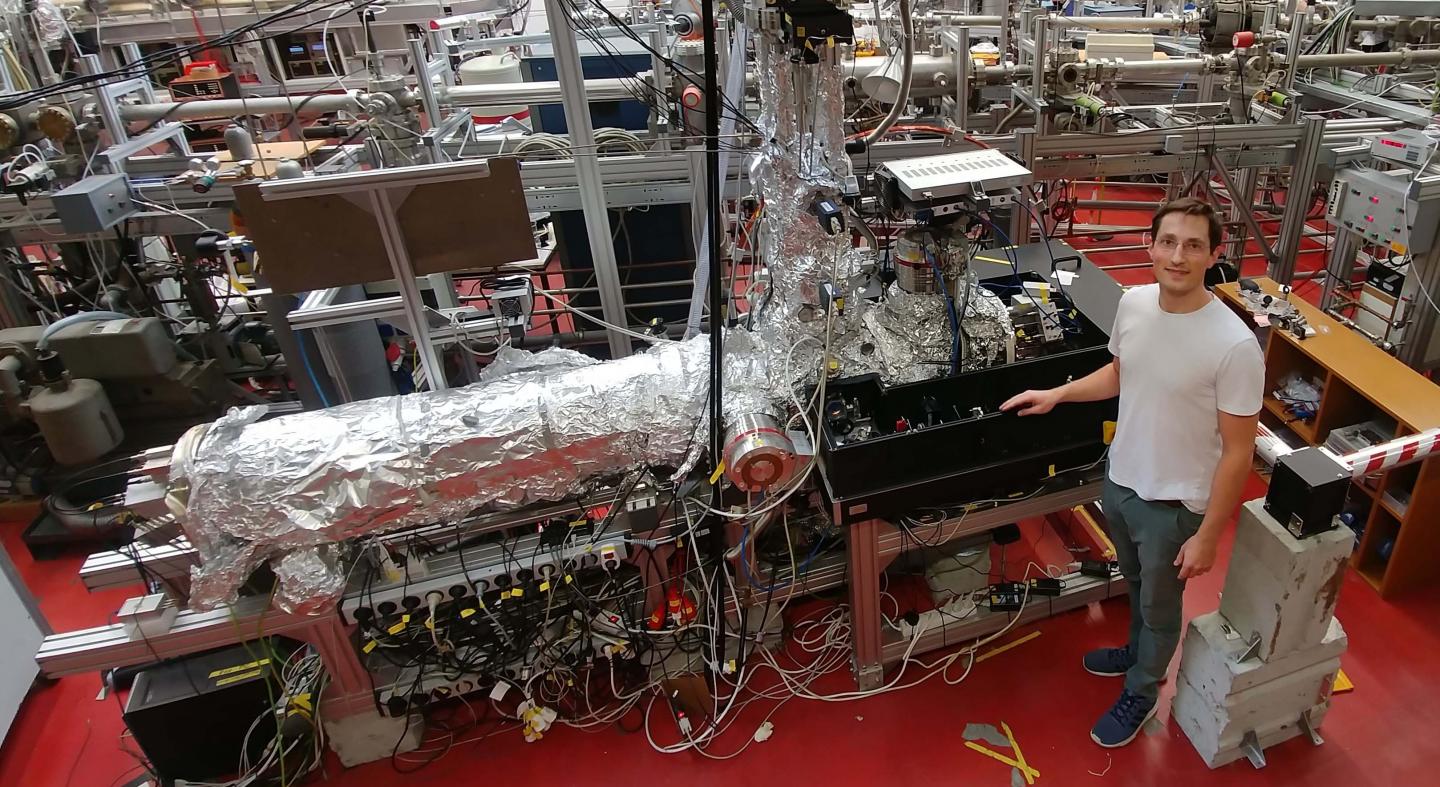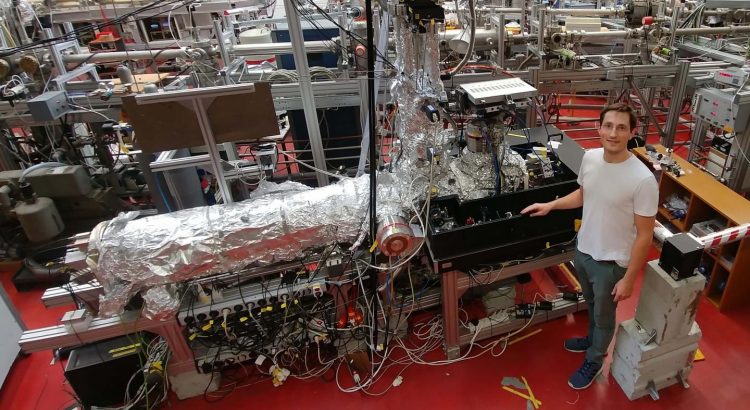Physicists at Goethe University measure miniscule effect with new super COLTRIMS apparatus / Publication in Nature Physics

Credit: Alexander Hartung
FRANKFURT. Albert Einstein received the Nobel Prize for explaining the photoelectric effect: in its most intuitive form, a single atom is irradiated with light. According to Einstein, light consists of particles (photons) that transfer only quantised energy to the electron of the atom. If the photon’s energy is sufficient, it knocks the electrons out of the atom. But what happens to the photon’s momentum in this process? Physicists at Goethe University are now able to answer this question. To do so, they developed and constructed and new spectrometer with previously unattainable resolution.
Doctoral student Alexander Hartung became a father twice during the construction of the apparatus. The device, which is three meters long and 2.5 meters high, contains approximately as many parts as an automobile. It sits in the experiment hall of the Physics building on Riedberg Campus, surrounded by an opaque, black tent inside which is an extremely high performing laser. Its photons collide with individual argon atoms in the apparatus, and thereby remove one electron from each of the atoms. The momentum of these electrons at the time of their appearance is measured with extreme precision in a long tube of the apparatus.
The device is a further development of the COLTRIMS principle that was invented in Frankfurt and has meanwhile spread across the world: it consists of ionising individual atoms, or breaking up molecules, and then precisely determining the momentum of the particles. However, the transfer of the photon momentum to electrons predicted by theoretic calculations is so tiny that it was previously not possible to measure it. And this is why Hartung built the “super COLTRIMS”.
When numerous photons from a laser pulse bombard an argon atom, they ionise it. Breaking up the atom partially consumes the photon’s energy. The remaining energy is transferred to the released electron. The question of which reaction partner (electron or atom nucleus) conserves the momentum of the photon has occupied physicists for over 30 years. “The simplest idea is this: as long as the electron is attached to the nucleus, the momentum is transferred to the heavier particle, i.e., the atom nucleus. As soon as it breaks free, the photon momentum is transferred to the electron,” explains Hartung’s supervisor, Professor Reinhard Dörner from the Institute for Nuclear Physics. This would be analogous to wind transferring its momentum to the sail of a boat. As long as the sail is firmly attached, the wind’s momentum propels the boat forward. The instant the ropes tear, however, the wind’s momentum is transferred to the sail alone.
However, the answer that Alexander Hartung discovered through his experiment is – as is typical for quantum mechanics – more surprising. The electron not only receives the expected momentum, but additionally one third of the photon momentum that actually should have gone to the atom nucleus. The sail of the boat therefore “knows” of the impending accident before the cords tear and steals a bit of the boat’s momentum. To explain the result more precisely, Hartung uses the concept of light as an electro-magnetic wave: “We know that the electrons tunnel through a small energy barrier. In doing so, they are pulled away from the nucleus by the strong electric field of the laser, while the magnetic field transfers this additional momentum to the electrons.”
Hartung used a clever measuring setup for the experiment. To ensure that the small additional momentum of the electron was not caused accidentally by an asymmetry in the apparatus, he had the laser pulse hit the gas from two sides: either from the right or the left, and then from both directions simultaneously, which was the biggest challenge for the measuring technique. This new method of precision measurement promises deeper understanding of the previously unexplored role of the magnetic components of laser light in atomic physics.
###
Images may be downloaded here: http://www.
Image 1: Photo of the COLTRIMS reaction microscope built by Alexander Hartung as part of his doctoral research in the experiment hall of the Faculty of Physics. Credit: Alexander Hartung
Image 2:Technical drawing of the newly constructed COLTRIMS reaction microscope. The drawing shows an intersection of the experimental construction. Individual gas atoms, which fly down through the vertical tube in the picture, are ionised by a highly intensive laser. The beam path of the laser is illustrated on the table in the back. The momenta of the electrons and ions that are produced in the reaction are measured with extreme precision by the horizontally depicted bronze-coloured spectrometer in the vacuum chamber. In this way, the effect of the miniscule momentum of the ionised laser light on the electrons can be studied precisely. Credit: Alexander Hartung
Publication:
A. Hartung, S. Eckart, S. Brennecke, J. Rist, D. Trabert, K. Fehre, M. Richter, H. Sann, S. Zeller, K. Henrichs, G. Kastirke, J. Hoehl, A. Kalinin, M. S. Schöffler, T. Jahnke, L. Ph. H. Schmidt, M. Lein, M. Kunitski, R. Dörner: Magnetic fields alter tunneling in strong-field ionization, in: Nature Physics, doi: 10.1038/s41567-019-0653-y.
https:/
Further information: Professor Reinhard Dörner, Alexander Hartung, Institute for Nuclear Physics, Faculty of Physics, Riedberg Campus, Phone.: +49 69 798-47003 or -47019; Email: doerner[at]atom.uni-frankfurt.de or hartung[at] atom.uni-frankfurt.de.
Current news about science, teaching, and society can be found on GOETHE-UNI online (http://www.
Goethe University is a research-oriented university in the European financial centre Frankfurt am Main. The university was founded in 1914 through private funding, primarily from Jewish sponsors, and has since produced pioneering achievements in the areas of social sciences, sociology and economics, medicine, quantum physics, brain research, and labour law. It gained a unique level of autonomy on 1 January 2008 by returning to its historic roots as a “foundation university”. Today, it is one of the three largest universities in Germany. Together with the Technical University of Darmstadt and the University of Mainz, it is a partner in the inter-state strategic Rhine-Main University Alliance. Internet: http://www.
Publisher: The President of Goethe University Editor: Dr. Anne Hardy, Science Editor, PR & Communication Department, Theodor-W.-Adorno-Platz 1, 60323 Frankfurt am Main, Tel: -49 (0) 69 798-13035, Fax: +49 (0) 69 798-763 12531, [email protected].
Media Contact
Reinhard Doerner
[email protected]
Original Source
https:/
Related Journal Article
http://dx.





